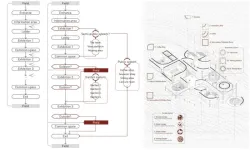(Press-News.org) Arlington, Va. — January 25, 2024 — A new study published today in the American Journal of Infection Control (AJIC) demonstrates that viral particles spread to many restroom surfaces during toilet flushing, regardless of whether the toilet lid is up or down. In this analysis, the only meaningful way of reducing viral particles was through disinfection of the toilet, toilet water, and nearby surfaces.
Scientists have long known that the process of toilet flushing can aerosolize pathogens expelled into the toilet bowl by an unhealthy individual. The aerosol plume created from the force of flushing can travel five feet or more, spreading pathogens to floors, walls, sinks, and other nearby surfaces in a bathroom.1 Prior studies have found that closing the toilet lid can help reduce the spread of bacterial pathogens, but until now, there has not been a report of whether the same is true for viral pathogens, which tend to be much smaller than their bacterial counterparts.
In this new study, scientists from the University of Arizona and research firm Reckitt Benckiser analyzed the spread of viral particles induced by toilet flushing, with toilet lids open and closed to determine any difference in outcome. Using a virus that is not pathogenic to humans as a proxy for more dangerous viruses, they seeded toilets with varying doses of the virus, flushed, and then collected samples from the toilet bowl water as well as surfaces on the toilet, floor, and walls. In a separate analysis of the effectiveness of cleaning the toilet with a disinfectant, samples were also collected from the toilet bowl brush and its caddy. The study included both household and public toilets; the impact of toilet lid closure could only be studied with the household toilet since public toilets typically do not have lids.
With the household toilet, researchers found that there was no statistical difference in the amount of virus collected from surfaces on the toilet or the nearby floor whether the toilet was flushed with the lid up or down. Viral contamination of the surrounding walls was minimal in both cases, while the toilet seat was the most contaminated surface. Similar patterns of contamination were observed with the public toilet.
The study also reviewed the effects of cleaning the toilet, both with and without disinfectant. Cleaning with only the brush left behind substantial contamination, but cleaning the toilet bowl with a disinfectant and brush significantly reduced the amount of virus found in the toilet. Results show that adding disinfectant to the toilet bowl before flushing or using disinfectant dispensers in the toilet tank were both effective ways to reduce contamination from flushing.
“In healthcare settings, any potential means of pathogen transmission must be addressed to keep all of our patients — including the most vulnerable, such as immunocompromised individuals — as healthy as possible,” said Charles P. Gerba, PhD, professor of virology at the University of Arizona and senior author of this study. “With results showing that closing toilet lids has no meaningful impact on preventing the spread of viral particles, our study highlights the importance of regular disinfection of toilets to reduce contamination and prevent the spread of viruses.”
Additional findings from the study include:
Cleaning with a disinfectant and brush reduced viral contamination on the toilet by more than 99.99% and on the brush by 97.64%.
Closing the toilet lid may alter the direction of the aerosol plume. In this study, floor surfaces in front of and to the left of the toilet were more contaminated after flushing with a closed lid than with an open lid, and floor surfaces to the right of the toilet were less contaminated.
These findings extend to households. When one member of a household is sick, particularly with an infection that causes gastroenteritis, the regular incorporation of a disinfectant during cleaning or prior to flushing may help reduce the spread of infection to others in the household.
“This study helps establish a clearer understanding of how pathogens spread and the measures we can take to break those chains of transmission,” said Tania Bubb, PhD, RN, CIC, FAPIC, 2024 APIC president. “It also underscores the importance of regular disinfection of surfaces in healthcare settings for reducing the spread of viral infections.”
References
1. Crimaldi JP, True AC, Linden KG, Hernandez MT, Larsen LT, Pauls AK. Commercial toilets emit energetic and rapidly spreading aerosol plumes. Sci Rep. 2022;12:20493. https://doi.org/10.1038/s41598-022-24686-5.
About APIC
Founded in 1972, the Association for Professionals in Infection Control and Epidemiology (APIC) is the leading association for infection preventionists and epidemiologists. With more than 15,000 members, APIC advances the science and practice of infection prevention and control. APIC carries out its mission through research, advocacy, and patient safety; education, credentialing, and certification; and fostering development of the infection prevention and control workforce of the future. Together with our members and partners, we are working toward a safer world through the prevention of infection. Join us and learn more at apic.org.
About AJIC
As the official peer-reviewed journal of APIC, The American Journal of Infection Control (AJIC) is the foremost resource on infection control, epidemiology, infectious diseases, quality management, occupational health, and disease prevention. Published by Elsevier, AJIC also publishes infection control guidelines from APIC and the CDC. AJIC is included in Index Medicus and CINAHL. Visit AJIC at ajicjournal.org.
NOTES FOR EDITORS
“Impacts of lid closure during toilet flushing and of toilet bowl cleaning on viral contamination of surfaces in United States restrooms,” by Madison P. Goforth, Stephanie A. Boone, Justin Clark, Priscilla B. Valenzuela, Julie McKinney, M. Khalid Ijaz, and Charles P. Gerba, was published online in AJIC on January 25, 2024. Available at: https://doi.org/10.1016/j.ajic.2023.11.020
AUTHORS
Charles P. Gerba, PhD (Corresponding author: gerba@arizona.edu), University of Arizona
Madison P. Goforth, PhD, University of Arizona
Stephanie A. Boone, PhD, University of Arizona
Justin Clark, MS, University of Arizona
Priscilla B. Valenzuela, MS, University of Arizona
Julie McKinney, PhD, Reckitt Benckiser LLC
M. Khalid Ijaz, DVM, MSc (Honors), PhD, FRSPH, Reckitt Benckiser LLC
# # #
END
European forests with a greater diversity of tree species are more resilient to storms, according to new research published in the British Ecological Society journal, Functional Ecology.
A new study by researchers at the French National Research Institute for Agriculture, Food and Environment (INRAE) reveals that in Europe, the forests that are most resilient to storms are those with a greater diversity of tree species and dominated by slow growing species with high wood density, like oaks.
The researchers also found that the positive effect of ...
While sustainability reporting is a widespread practice in the private sector, new research shows that the same cannot be said for Ontario municipalities.
Researchers at the University of Waterloo studied 38 municipalities in Ontario, representing more than two-thirds of the population, and discovered that almost all municipalities publish their sustainability and climate change goals, but under half are formally reporting on their progress.
Municipalities are a key part of the equation ...
A collaborative research team co-led by Professor Shuang ZHANG, the Interim Head of the Department of Physics, The University of Hong Kong (HKU), along with Professor Qing DAI from National Center for Nanoscience and Technology, China, has introduced a solution to a prevalent issue in the realm of nanophotonics – the study of light at an extremely small scale. Their findings, recently published in the prestigious academic journal Nature Materials, propose a synthetic complex frequency wave (CFW) approach to address optical loss in polariton propagation. These findings offer practical solutions such as more efficient light-based devices for faster and ...
Two innovative teaching and learning projects led by The University of Hong Kong (HKU) earned honours in the Quacquarelli Symonds (QS) Reimagine Education Awards, presented in Abu Dhabi in December 2023.
Often referred to as the "Oscars of Education," the awards are designed to honour the most innovative and effective approaches to enhancing student learning experiences and employability outcomes.
The 2023 QS Reimagine Education Awards received a record number of more than 1,200 submissions across 17 categories. HKU has garnered ...
The Fukushima Daiichi nuclear disaster, triggered by the earthquake and tsunami on March 11, 2011, resulted in a severe release of radioactive materials, including cesium, from the damaged nuclear reactors. The loss of cooling capabilities led to partial meltdowns in the reactor cores, releasing a substantial amount of cesium-137 (Cs-137) and cesium-134 (Cs-134) into the environment. The release of Cs-137, in particular, poses environmental and human health hazards due to its long half-life and high mobility in the environment. Environmentally, Cs-137 contributes ...
This essay writes on a building project in the remote southwestern China that is built in uninhabited and is inspired and informed by its landscape context. The essay discusses how an extraordinary building project reacts to three different dimensions about landscape–architecture—a natural terrain being manipulated and recast. A small building needs to find its precise connecting point to a much larger historical and environmental context. A practical project needs to reach a balance between architectural pursuits and engineering concerns. Initially, artificial works might be isolated from and in conflict with the terrain, which requires architectural approaches ...
Flinders University researchers say that cohesive and collaborative action from preventive health communicators and organisations is needed to inform young people about the devastating harms of vaping.
“Despite awareness of the potential harms, recreational vaping is increasing among younger people with our South Australian participants seeing vaping as ‘cleaner’ and less harmful than cigarettes,” says Flinders University’s Dr Joshua Trigg.
“We know that nicotine vapes are highly addictive and expose people to harmful chemicals, respiratory irritants, and toxic substances. In order to discourage ...
Kyoto, Japan -- Our understanding of the world relies greatly on our knowledge of its constituent materials and their interactions. Recent advances in materials science technologies have ratcheted up our ability to identify chemical substances and expanded possible applications.
One such technology is infrared spectroscopy, used for molecular identification in various fields, such as in medicine, environmental monitoring, and industrial production. However, even the best existing tool -- the Fourier transform infrared spectrometer or FTIR -- utilizes a heating element as its light source. Resulting detector noise in the infrared region limits the devices' ...
According to a new analysis, almost a quarter of Australians with disabilities smoke when compared to just 12.6% of the wider population.
While the number of Australians smoking is declining, the barriers for people with disabilities mean targeted support is needed to develop healthier habits.
Flinders University and Cancer Council NSW health experts are recommending new strategies to tackle the alarming smoking rate through targeted government policies, data collection on smoking and training for disability support workers on tobacco prevention ...
A Rutgers Health analysis of millions of Medicare records has laid the groundwork for improving end-of-life care by demonstrating that nearly all older Americans follow one of nine trajectories in their last three years of life.
“Identifying which paths people actually take is a necessary precursor to identifying which factors send different people down different paths and designing interventions that send more people down whatever path is right for them,” said Olga Jarrín, the Hunterdon Professor of Nursing Research at Rutgers and corresponding author of the study published in BMC Geriatrics.
The team pulled the final three years of clinical records ...






